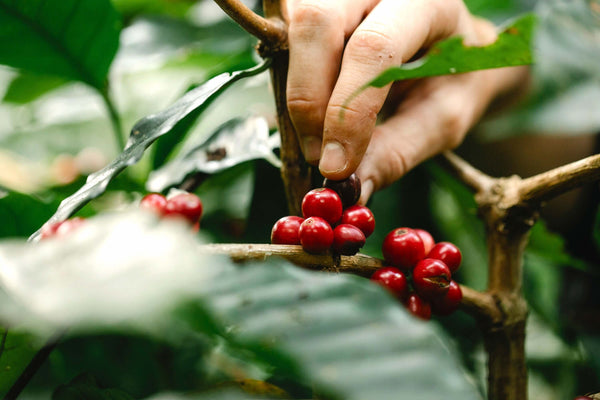
Shade Grown vs. Sun Grown Coffee
tai attitude6 min read
The coffee agricultural system plays a big factor in why the quality we perceive in coffee can be what it is.
Not all coffee tastes the same because, in the first place, each is not grown the same. Taste aside, the agricultural system used in coffee farming will also affect both environmental and economic sustainability.
In this article, let us dive into the two main agricultural systems of coffee farming.
|
Shade-grown |
|
Sun-grown |
|
Our support |
Shade-grown
Shade-grown coffee is a form of the crop produced from coffee plants grown under a canopy of trees.
Naturally, in the wild, coffee plants grow in the forest understory, which is under the shade of larger trees, without requiring full sun exposure. When mankind domesticates coffee, the coffee plant is then grown under other large trees that provide shading, mimicking the natural growing conditions of the coffee plant in its native forest understory. This agricultural system is known as the shade grown method, and it has been the traditional way for coffee cultivation for hundreds of years.
 A shade-grown coffee farm in Colombia.
A shade-grown coffee farm in Colombia.
The shade tree used for the shade-grown method is usually a larger tree with big leaves to provide optimal shading for the coffee plant under it. As such, fruit or timber trees are often utilised as shade trees, growing alongside the coffee plant on a shade-grown coffee farm.
The benefits of the shade-grown method cannot be understated. First, the coffee plant’s exposure to the sun is moderate; this allows the coffee plant to take a longer time to mature and develop a higher sugar content, thereby reducing its acidity and bitterness. Second, with less stress from the sun, the coffee plant can live twice as long when compared to its sun-grown counterpart. Third, coffee plants have more spacing between them, allowing for better nutrient absorption from the soil, which further benefits the quality. Fourth, the need for farmers to use pesticides is less likely due to the presence of wild birds as natural predators to deter pests, as shade-grown environments are habitats for birds and other small animals. Fifth, the shade tree helps in not only shading but also shielding the wind for the coffee plant, which increases its resistance to extreme weather. Sixth, fallen leaves and foliage from shade trees act as natural fertiliser for the coffee plant when decomposed on the soil. Seventh, growing shade trees such as fruit or timber trees will allow farmers to further supplement their income.
Overall, the shade-grown environment is a biodiverse ecology that is highly environmentally sustainable, and it is, without question, still the highest quality way to grow coffee.
The downsides of the shade-grown method are a longer coffee plant maturing period and a lower crop yield.
Shade-grown coffee is more expensive for its higher quality, lower crop yield, and labour cost. Due to its terrain, harvesting the coffee fruit is done by hand by the farmers, and this does increase the quality of the coffee grades. Furthermore, hand-picking provides extra income and job opportunities for the farmers as well.
 Shade-grown coffee requires coffee fruit to be hand-picked during harvest.
Shade-grown coffee requires coffee fruit to be hand-picked during harvest.
Shade-grown coffee is often labelled “shade-grown” on the coffee bean’s packaging or websites. Other keywords, such as bird-friendly or organic, are also indicators that the coffee has been shade-grown.
Most coffee farms in Central and South American coffee-producing countries use the shade-grown method. Coffee farms in countries such as Colombia, Mexico, El Salvador, Peru, Panama, Honduras, Nicaragua, Guatemala, and African countries like Ethiopia.
Another way to identify shade-grown coffee is by cultivar. Certain older arabica cultivars, such as Typica, Gesha, etc., require being shade-grown as these cultivars do not have the genetic trait to survive direct sun.
Sun-grown
Sun-grown coffee is a form of the crop produced from coffee plants that are grown directly under the sun.
Starting in the 1970s, coffee farms in parts of the world replaced the traditional shade-grown method with a newer agricultural system known as the sun-grown method. The main reason for the transition is to increase coffee production (for better income and the economy) to meet the ever-rising global coffee market demand.
 Sun-grown coffee plantation in Brazil.
Sun-grown coffee plantation in Brazil.
There are benefits to the sun-grown method on its own. First, sun-grown coffee plants mature quicker and yield more fruits per harvest cycle. Second, the farmer could grow more coffee plants per acre, thereby increasing production. Third, due to the large openness of the farm, the management of the sun-grown method is easier, reducing the cost of production. Fourth, during harvest season, mechanical harvesting is possible, further reducing the cost of production and increasing the efficiency of harvest. Fifth, the coffee produced by the sun-grown method has a higher overall chlorogenic acid content, which is responsible for more bitter-related flavours. All the same, it also means higher antioxidant content, a trade-off.
The downsides of the sun-grown method are deforestation, which destroys biodiversity, climate change, and animal habitat loss, especially for birds. Without the nourishment of biodiversity, sun-grown coffee plants have a much shorter life span. The absence of birds as natural predators of coffee pests will call for the use of pesticides on the coffee plant. Without the shade trees or other plants providing fallen leaves and foliage to the soil as natural fertiliser, the depleted soil nutrients cannot be replaced over time, which will require the use of man-made fertiliser (nitrates) for the coffee plant. In addition, having no other larger plants in the surrounding area to absorb water during heavy rainfall will lead to fertilisers (nitrates) being carried by water, causing soil erosion and pollution of the nearby water source over time.
 Mechanical harvesting is possible with the sun-grown method.
Mechanical harvesting is possible with the sun-grown method.
Sun-grown coffee is not labelled on the coffee bean’s packaging or websites.
The sun-grown method is used on coffee farms in countries that are more wet or rainy, as coffee plants grown in these countries will need more sun. Most coffee farms or plantations in Brazil, Yemen, Kenya, Hawaii, Jamaica Blue Mountain, and Sumatra Mandheling use the sun-grown method.
Certain arabica cultivars, such as Bourbon, Caturra, Catuai, Catimor, etc., have the genetic trait to survive direct sunlight, hence being sun-grown compatible. Seasonal coffee drinkers will know that these cultivars are responsible for some of the best flavour in the cup, for sun-grown coffee can be of high quality. On the other note, all of Robusta's cultivars are sun-grown compatible.
Our support
For buyers, know that specialty graded coffee can be either shade- or sun-grown; fair trade certified coffee is mostly shade-grown, and organic-certified coffee is 100% shade-grown. If your reason or supporting cause is environmental sustainability, buying shade-grown coffee is the right move.
This is not to say sun-grown is not good; in fact, it has its own merits. The sun-grown method makes high crop yields and a larger scale of coffee cultivation possible, which in turn makes it possible to meet the ever-rising world coffee demand. Global coffee prices can be kept in check, allowing more people to afford coffee. Since most coffee production comes from developing countries, being able to export more coffee annually improves their country's economy, thereby improving their livelihood. Hence, buying sun-grown coffee supports a different good cause.
So what is the key takeaway? We would say both shade-grown and sun-grown methods can produce high-quality coffees in their own right. There is no perfect coffee agricultural system out there yet, as currently one is more environmentally sustainable and another is more economically sustainable.




2 comments
To: Mamo
Thank you for reading our humble article. We appreciate what you do. You have a great day.
Author/Barista Tai
I’m coffee farmer, got some additional ideas from u’r article, thanks